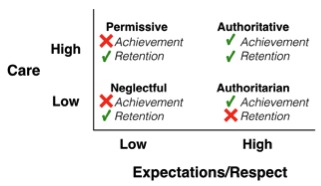Jump to: Significance ~ Conceptualization
Significance of Interpersonal Relationships Among Members of a School Community
Relationships are the PRIMARY vehicle for education, and a crucial tool for educators. These include relationships between and among all members of a school community: Students, student families, and educators. The scientific literature on interpersonal relationships among members of a school community consistently finds that stronger relationships among community members contribute to:
- Improved student academic engagement
- Reduced student disruptive behavior
- Greater student academic achievement
- Higher student graduation rates
- Reduced teacher burnout
- Lower rates of teacher turnover
Suggested Reading
- Fredricks, J. A., Blumenfeld, P. C., & Paris, A. H. (2004). School engagement: Potential of the concept, state of the evidence. Review of Educational Research, 74(1), 59–109.
- Minke, K. M., Sheridan, S. M., Kim, E. M., Ryoo, J. H., & Koziol, N. A. (2014). Congruence in parent-teacher relationships: The role of shared perceptions. The Elementary School Journal, 114(4), 527–546.
- O’Connor, E. E., Dearing, E., & Collins, B. A. (2011). Teacher-child relationship and behavior problem trajectories in elementary school. American Educational Research Journal, 48(1), 120–162.
- Osher, D., Bear, G. G., Sprague, J. R., & Doyle, W. (2010). How can we improve school discipline? Educational Researcher, 39(1), 48–58.
- Pomaki, G., DeLongis, A., Frey, D., Short, K., & Woehrle, T. (2010). When the going gets tough: Direct, buffering and indirect effects of social support on turnover intention. Teaching and Teacher Education, 26(6), 1340–1346.
- Roorda, D. L., Koomen, H. M., Spilt, J. L., & Oort, F. J. (2011). The influence of affective teacher–student relationships on students’ school engagement and achievement a meta-analytic approach. Review of Educational Research, 81(4), 493–529.
- Sugai, G., & Horner, R. (2002). The evolution of discipline practices: School-wide positive behavior supports. Child & Family Behavior Therapy, 24(1-2), 23–50.
Conceptualizing Student-Teacher Relationships: Teachers’ Relational Style
The Parenting Styles Framework, originally developed by Diana Baumrind, has been applied to educational settings, focusing on student retention and academic achievement as the main outcomes of interest. The framework defines two main elements of teachers’ relational style: (1) Care (the communication of warmth, caring, acceptance, and concern for the emotional well being of a student) and (2) Expectations/Respect (the communication of high expectations regarding student behavior and achievement, as well as respect for the student as an autonomous and capable individual).
Teachers’ must communicate high levels of care and high expectations/respect in order to achieve high levels of retention and academic achievement. This relational style is commonly referred to as “authoritative”, and is one of 4 broad categories of relational styles, each of which is depicted in the figure below, along with their corresponding retention and academic achievement outcomes.
Suggested Reading
- Gregory, A., Cornell, D., & Fan, X. (2011). The Relationship of School Structure and Support to Suspension Rates for Black and White High School Students. American Educational Research Journal, 48(4), 904–934.
- Pellerin, L. A. (2005). Applying Baumrind’s parenting typology to high schools: toward a middle-range theory of authoritative socialization. Social Science Research, 34(2), 283–303.
- Walker, J. M. (2008). Looking at Teacher Practices Through the Lens of Parenting Style. The Journal of Experimental Education, 76(2), 218–240.
- Walker, J. M. (2009). Authoritative classroom management: How control and nurturance work together. Theory Into Practice, 48(2), 122–129.
- Wentzel, K. R. (2002). Are effective teachers like good parents? Teaching styles and student adjustment in early adolescence. Child Development, 73(1), 287–301.
